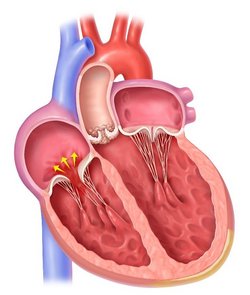TRICUSPID REGURGITATION (TR)
TRICUSPID REGURGITATION (TR)
The tricuspid valve separates the right lower heart chamber (the right ventricle) from the right upper heart chamber (right atrium). Tricuspid regurgitation (TR) is a condition in which this valve does not close properly, causing blood to flow backward (regurgitate) into the right atrium each time the right ventricle contracts.1

Symptoms of tricuspid regurgitation
TR places an extra burden on the heart and lungs, and the heart may have to work harder to function normally. It is possible for a person to have TR without experiencing any symptoms. In some cases, some of the following symptoms may be experienced1,2:

Shortness of breath

Fatigue or weakness

Abdominal swelling

Swollen feet or ankles

Pulsing in neck veins

Heart rhythm problems (arrhythmias)
Moderate or severe TR can significantly
impact quality of life for patients.2
- Tricuspid regurgitation treatment
Treatment for TR depends on how severe the condition is and what caused it. Mild TR may not cause symptoms or require treatment. If the condition is severe and causing symptoms, medications, surgery or tricuspid Transcatheter Edge-to-Edge Repair (TEER) may be needed. The goal of treatment is to improve the heart’s function while minimizing symptoms, preventing complications, and improving quality of life.1
- Medications: A doctor may prescribe medications to help manage TR symptoms, such as water pills (diuretics) to remove excess fluid from the body, or medications to treat an underlying condition that is causing TR1
- Surgery: The Tricuspid valve may need to be repaired or replaced, which is usually performed through surgery1
- Tricuspid TEER: If the doctor determines that tricuspid valve surgery is not an option—due to age, advanced heart failure, or other associated medical conditions—a minimally invasive treatment option called transcatheter edge-to-edge repair may be a possibility
If left untreated, TR can lead to heart failure and death2
A person with severe TR may be at too high a risk for open-heart surgery, but may be eligible for a minimally invasive treatment option called transcatheter edge-to-edge repair (TEER).
MAT-2202029 v2.0 | Item approved for OUS use only.